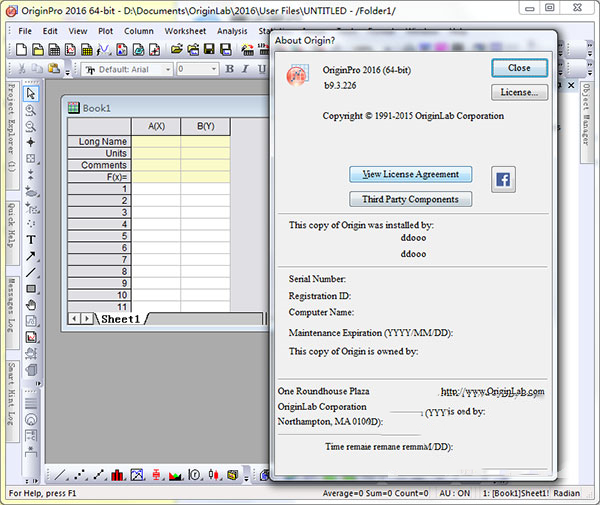- Green versionView
- Green versionView
- Green versionView
- Green versionView
- Green versionView

Origin2016 software introduction
OriginPro 2016 provides you with a variety of tools and options for importing, converting, processing, and graphing to analyze data and publish research results. It can not only meet the graphing needs of general users, but also meet the needs of advanced users for data analysis and function fitting. Although this software is a professional function software, its operation is not as difficult as we imagined. Most of the entire drawing process of the software is based on templates. The system itself has provided users with dozens of two-dimensional and three-dimensional drawing templates, and it also allows users to customize templates for use. In some colleges and universities, OriginPro 2016 is also regarded as one of the software that must be mastered.
Origin2016 function introduction
Export multi-page table workbook to Excel file
Copy graphics and paste directly into online documentation tools such as Confluence pages
Option to export multiple graphics into a single multi-page PDF file
Export charts with the PE folder name included in the name of the exported file
Copy/export user-defined areas of graphics pages
Ignore hidden columns in ASCII export
Export the graphics in the project subfolder to the corresponding subfolder under the project folder in Windows Explorer
Improvements in sending charts to PowerPoint: specify chart list and order, specify slide layout and style
Create movies from Origin Windows using GUI tools or scripts
Graphics export supports transparency in PDF and EPS formats
Export all charts to PowerPoint
Export ASCII data to existing files by appending or replacing
SLIDESHOW DRAWING AND LAYOUT
Export worksheets as images, WAV, NI TDM/TDMS files or multi-page PDF documents
Graphic export formats include: AI, CGM, EPS, TIFF, PDF, JPEG, EMF, PSD, etc.
Export images to raster file format
Origin2016 software features
You can import a variety of data including ASCII, Excel, and pClamp. In addition, it can output the software's graphics to image files in various formats, such as JPEG, GIF, EPS, TIFF, etc.
It also supports programming to facilitate the expansion of software functions and execution of batch processing tasks. There are two programming languages in the software-LabTalk and Origin C.
Based on the original foundation, users can create the special tools they need by writing X-Function. X-Function can call Origin C and NAG functions, and interactive interfaces can be easily generated. Users can customize their own menus and command buttons, put X-Function on menus and toolbars, and then use their own customized tools very conveniently. (Note: X-Function is supported starting from version 8.0. Previous versions of this software mainly used Add-On Modules to extend the functionality of Origi software.

Origin2016 Instructions for Use
Verify origin analysis results
From the Help menu, select Learning Center (or press F11). NOTE: If you are prompted to download and install an update for the Learning Center, please do so now! There is a critical bug fix.
In the Learning Center dialog box, select the Analyze Samples vertical tab.
From the Samples In drop-down list, select Validation.
You will observe the sample list.
Click on any sample to open it in the current Origin session.
Once the sample is open, you will be prompted to run the analysis in Origin.
If you click OK, Origin will run the analysis and output the results to HTML Report window (see image below). The report is pre-populated with relevant NIST validated data and results for easy comparison to Origin results.
Origin's results and NIST results show that the results are completely or almost completely consistent. (Note: If you would like to view NIST information, there is a helpful link on the report page.)
Hint!!! You can see that the following report has background color cells. If you were to print one of the reports, the background color would not be printed. This is the default behavior of HTML containers that display reports. If you really need a background color, click once in the report to activate it. Then, select Page Setup from the File menu... In the Page Setup dialog box, check Print background colors and images ” checkbox. From now on, HTML reports will be printed with a background color!
Without giving too much background information, Unicode treats text "characters" as integer-based code points, rather than actual characters themselves. In UTF-8, these code points are broken down into a sequence of 1 to 4 bytes, with the ASCII range taking up 1 byte and other languages varyingly taking up 2, 3 or 4 bytes. For those interested, this is a good discussion of the subject.
Let’s look at some actual text data and break it down to illustrate what’s going on. In the table below we see the Simplified Chinese version of the "Experiment #1" text: Experiment #1. The most important thing to note is that the first two code points take up 3 bytes each, while the last 3 code points take up 1 byte each because they are in the ASCII range. Also note that there is a 1 to 1 relationship between "visual roles" (glyphs) and code points. This is true for the vast majority of cases, but there are some exceptions listed at the end of this article.
What does this mean for LabTalk or OriginC programmers who want to manipulate data that contains non-ASCII UTF-8 encoded data? Let’s take a look.
LabTalk
To properly support UTF-8 encoded text strings, a new system variable was added in 2018 @ SCOL. When it is set to 1 (the default), most common LabTalk string functions and methods of LabTalk string objects will utilize code points for character offsets and character counts (as in Excel). If @SCOL is set to 0 (zero), those functions will use the number of bytes for the offset and the number of bytes for the count. Remember that in LabTalk, offset and position are 1-based.
So if we apply the two LabTalk string functions Len() and Mid() to the Simplified Chinese text shown in the table above, we can see how the results differ between using code points versus bytes:
Please note that when using the code point (@SCOL = 1), Len() returns the expected number and Mid() returns the expected substring. But if we look at the results when using bytes (@SCOL = 0) and referring to the table above, we can see that Len() gives the number of bytes used for the text string. Mid() starts from byte #4 and returns byte #4 and byte #5. Well, these two bytes are part of a 3-byte code point. This means that the substring returned is incomplete and basically garbage.
Although LabTalk now supports correct UTF-8 encoded text strings, there are some limitations on where non-ASCII range text can be used in scripting. " It is not supported by Script Window or Command Window. If you output non-ASCII range text (more than 1 byte per "character") or enter non-ASCII range string literals into either of these windows, there is a good chance that garbage will be displayed in place of the text. On the other hand, output to the results log or message log or dialog box will display the text correctly.
If you need to use UTF-8 encoded text outside the ASCII range in a LabTalk script, you must use an OGS file. More importantly, the actual OGS file must be saved as UTF-8 with a Byte Order Mark (BOM) added to the file in order for the script to execute correctly. The code generator will prompt you to save the OGS file as UTF-8 and automatically add the BOM if needed, but other text editors may not do this. For example, NotePad can save UTF-8 and automatically add BOM, but unless otherwise specified, NotePad ++ will not add BOM. So if it's not Code Builder, it's a good idea to determine what your text editor of choice is doing.
Note: Old LabTalk Substring notation will not support UTF-8 strings outside the ASCII range and there are no plans to implement it. However, you are encouraged to use modern string functions, so this shouldn't cause too much of a problem for new scripts.
Finally, it is a very good practice not to try to use variable or function names in LabTalk outside the ASCII range. This is a general best practice in most programming languages, not just LabTalk.
Origin2016 update log
1. Sweep the bug out and carry it out to the end
2. The most stable version ever
Extraction code: qbbe
Huajun editor recommends:
Origin2016 can help you solve many problems. I believe that as long as you dare to use it, you will definitely not be able to put it down. I also recommend it to you.Today's goal,Aimo mind map,WPS Office,NTKO large file upload control,Kuai Dao Ke platform software








































Useful
Useful
Useful